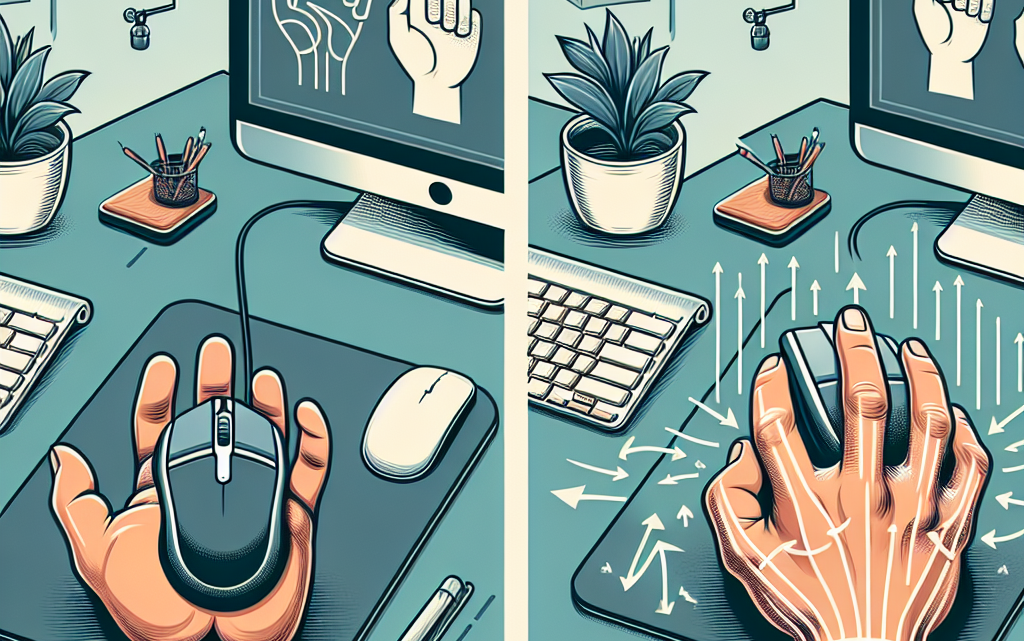Understanding Wrist Strain
Wrist strain is a common issue among individuals who spend long hours working on computers. It is characterized by pain, discomfort, and a sense of weakness in the wrist and sometimes the forearm. This condition can be exacerbated by improper positioning of the wrist and hand while using a mouse. With the growing prevalence of computer-related work, finding solutions to reduce the risk of wrist strain has become essential.
Importance of Ergonomic Mouse Pads
Ergonomic mouse pads are designed specifically to promote proper wrist alignment and reduce strain. The features of these pads can significantly impact user comfort and overall productivity. Below is a table that highlights the key characteristics of ergonomic mouse pads and how they contribute to minimizing wrist strain.
| Feature | Description | Benefit |
|---|---|---|
| Raised Padded Support | Padded wrist support raises the wrist to a neutral position. | Helps prevent extension and flexion strain. |
| Soft Material | Made from soft and comfortable materials such as gel or foam. | Reduces pressure on the wrist. |
| Non-Slip Base | Features a non-slip base to keep the pad in place. | Prevents unnecessary wrist movement and misalignment. |
| Size and Shape | Various sizes and shapes to suit different preferences. | Provides a personalized fit for enhanced comfort. |
How Ergonomic Mouse Pads Work
Ergonomic mouse pads work by promoting a more natural hand and wrist position during use. The key factors that contribute to their effectiveness include:
1. Promoting Neutral Wrist Position
When using a standard mouse pad, the wrist often bends at awkward angles, which can lead to discomfort over time. Ergonomic mouse pads are designed to keep the wrist in a neutral position, reducing stress on the tendons and ligaments. The raised support allows the wrist to rest comfortably, minimizing unnecessary movements that can cause strain.
2. Providing Cushioning
Most ergonomic mouse pads are made from materials that provide cushioning and support. This padding helps absorb some of the pressure exerted on the wrist when using a mouse for extended periods. By distributing pressure evenly, these pads can help prevent soreness and fatigue.
3. Encouraging Proper Posture
Using an ergonomic mouse pad encourages better overall posture. When the wrist is supported appropriately, it helps maintain the alignment of the hand, arm, and shoulder. This alignment can prevent compensatory movements that often lead to discomfort and strain in the wrist and forearm.
4. Reducing Repetitive Strain Injury (RSI)
Repetitive Strain Injury (RSI) is a condition that results from prolonged repetitive motion, such as clicking a mouse. By employing an ergonomic mouse pad, users can reduce the risks associated with RSI. With improved wrist support and alignment, the amount of strain placed on the wrist during repetitive movements is mitigated, allowing for longer, more comfortable periods of use.
Choosing the Right Ergonomic Mouse Pad
When selecting an ergonomic mouse pad, there are several factors to consider to ensure that it meets your needs:
- Comfort: Choose one with sufficient padding to provide comfort during long use.
- Material: Look for materials that can provide both firmness and support without being overly rigid.
- Size: Ensure the pad is sized appropriately for your workspace and mouse type.
- Shape: Select a shape that fits your hand size and ergonomic needs.
Popular Types of Ergonomic Mouse Pads
The market offers a variety of ergonomic mouse pads, each catering to different user needs:
1. Gel Mouse Pads
These pads feature a gel-filled wrist rest that provides softness and adaptability, conforming to the wrist’s shape while offering excellent support.
2. Memory Foam Mouse Pads
Memory foam pads are designed to distribute weight evenly and offer superior comfort by molding to the wrist’s contours.
3. Traditional Padded Mouse Pads
With a standard thickness of padding, these pads may lack advanced features but still provide better support than basic mouse pads.
Benefits of Using Ergonomic Mouse Pads
Switching to an ergonomic mouse pad can lead to several benefits that enhance overall well-being during computer use:
- Enhanced Comfort: Users often report improved comfort levels, reducing fatigue and discomfort.
- Increased Productivity: By alleviating discomfort, users can focus better on tasks without distraction.
- Long-Term Health Benefits: Regular use can help prevent chronic pain conditions associated with poor wrist posture.
Conclusion
In conclusion, ergonomic mouse pads play a vital role in reducing wrist strain and enhancing overall comfort for individuals who spend extended periods working on computers. By promoting a neutral wrist position, providing cushioning, and supporting proper posture, these pads can minimize the risk of repetitive strain injuries and other discomforts. As the importance of ergonomic office designs continues to grow, integrating ergonomic mouse pads into your workspace can be a simple yet effective step toward better wrist health and productivity.

